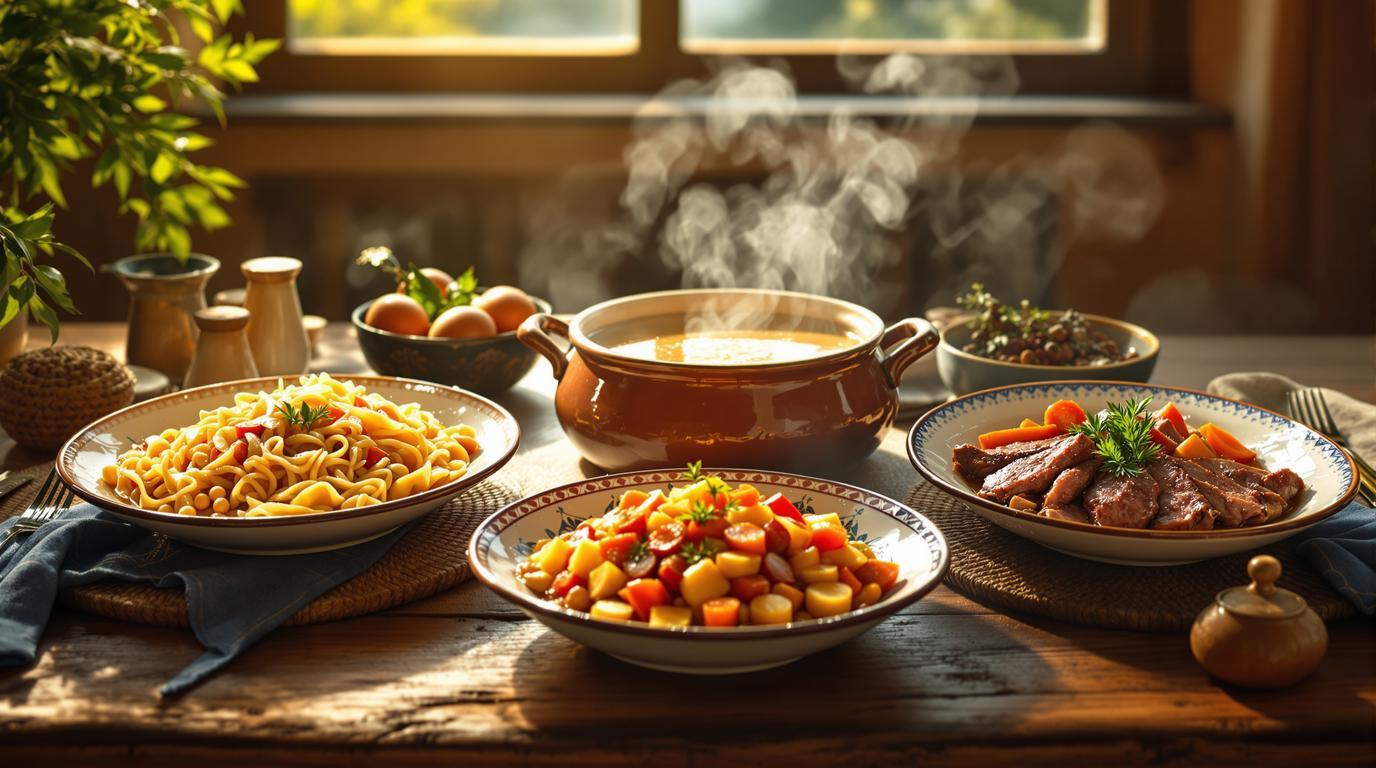There’s something deeply comforting about a traditional Cocido Madrileño that takes me back to my early days working in Spain. This iconic one-pot feast isn’t just a recipe—it’s a cultural institution that spans generations. I still remember my mentor Chef Rodrigo teaching me the three-service method, where the simple act of separating broth, vegetables, and meats transforms one pot into an entire multi-course experience. While modern kitchens have streamlined many classics, this centuries-old Spanish masterpiece remains gloriously, defiantly unhurried.
The Soul of Spanish Comfort Food 📖
Cocido Madrileño emerged from medieval Madrid’s humble kitchens—a practical way to create a complete meal from whatever was available. What began as necessity evolved into Spain’s most celebrated stew, traditionally prepared on Sundays when families gathered around tables for hours of conversation and connection. The genius lies in its three-course serving style: first a nourishing broth with noodles, then chickpeas with vegetables, and finally the tender, flavor-infused meats.
Much like Louisiana’s jambalaya with its Cajun trinity, Cocido brings together humble ingredients that transform during long, patient cooking.
The Essential Building Blocks 🧾
For authentic Cocido Madrileño (serves 6-8):
- 1 pound (450g) dried chickpeas, soaked overnight with 1 teaspoon baking soda
- 1 pound (450g) beef shin or marrow bones
- ½ pound (225g) beef shank (morcillo)
- 4 ounces (115g) Serrano ham (substitute: prosciutto)
- 8 ounces (225g) Spanish chorizo
- 4 ounces (115g) morcilla blood sausage (optional)
- 4 ounces (115g) pancetta or salt pork
- 2 medium onions, peeled and halved
- 4 large carrots, peeled and chunked
- 6 medium potatoes, peeled and quartered
- ½ head green cabbage, cored and rough-chopped
- 2 garlic cloves, peeled
- 1 cup thin noodles (fideos) or rice
- 2 tablespoons olive oil
- Salt to taste (added mid-cooking)
The Unhurried Method 📝
This is slow cooking at its finest—the kind that fills your home with irresistible aromas for hours:
- Drain and rinse your soaked chickpeas. If you’re short on time, you might try the ice water trick to speed things up, though traditional Cocido demands patience.
- In a large earthenware pot or Dutch oven, gently sauté onions and garlic in olive oil until translucent but not browned.
- Add the bones, beef shank, Serrano ham, and pancetta. Cover with cold water by two inches (about 4 quarts/liters).
- Bring to a gentle boil, then immediately reduce to a bare simmer. This is crucial—aggressive boiling will toughen the meat. Skim off any foam that rises to maintain a clear broth.
- Cover and simmer for 90 minutes, occasionally skimming.
- Add the drained chickpeas, carrots, and potatoes. Continue simmering for 30 minutes.
- Add the chorizo, morcilla (if using), and cabbage. Simmer for a final 20 minutes until everything is perfectly tender.
Chef’s Secret Techniques 🤫
The magic of Cocido isn’t just in what you add, but how you serve it. This three-stage presentation transforms one pot into an elegant progression:
Chef’s Note: The key to exceptional Cocido lies in properly skimming the broth during the first 30 minutes of cooking. These impurities would otherwise cloud the soup and create off-flavors. Patience here rewards you with liquid gold.
For authentic serving, strain the broth into a separate pot and cook the noodles in it for about 7 minutes. Serve this as your first course—a clear, aromatic soup that prepares the palate. For the second course, arrange the chickpeas and vegetables on a platter. Finally, slice the various meats for the third course. Each stage deserves its own moment in the spotlight.
Like the traditional French techniques I learned, this methodical approach elevates simple ingredients to something truly special.
From My Kitchen to Yours 🍽️
While this stew has similarities to the Greek kleftiko’s slow-cooked approach, Cocido’s defining characteristic is its celebration of each component. Don’t rush this dish—it’s meant to stretch across a leisurely afternoon, preferably shared with those you love.
If you’re looking for an unexpected twist, try adding a pinch of salt to your serving of broth, much like the surprising effect in Vietnamese coffee—it heightens the meaty flavors without making it salty.
There’s something beautiful about a recipe that’s sustained Spanish families for centuries. In our hurried world, Cocido Madrileño stands as a delicious reminder that sometimes, the most nourishing things can’t be rushed. Your kitchen will be perfumed with tradition, and your table will offer not just a meal, but an experience that connects you to generations of Spanish home cooks who understood that food is about more than sustenance—it’s about savoring life itself.
